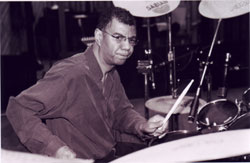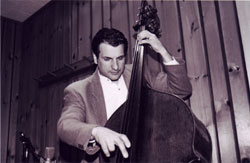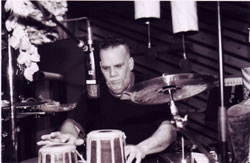

|
Soundclip:
|
| See Steve's Hand-Written Lead
Sheet |
|
Steve
Khan's
lead
sheet :  Of course, it could have been simple dumb luck too! I have never been afraid of having tracks on my recordings that exceed the "10-minute zone." And, once this piece had been laid-out in theory, I sensed that it would eventually be in that time frame too. But, I never expected that we would play and approach the 20-minute barrier. What you now hear is a representation of four spirits joined together, unafraid of traditional boundaries, and fueled by the relentless energy, creativity, fire, and musicality of Jack DeJohnette. Though it was a different time, I have never forgotten the sonority, the tone of Jack's then Paiste ride cymbals on Ralph Towner's spectacular title song from "BATIK"(ECM). To these ears, never was there more music in one ride cymbal! Of course, it could have been simple dumb luck too! I have never been afraid of having tracks on my recordings that exceed the "10-minute zone." And, once this piece had been laid-out in theory, I sensed that it would eventually be in that time frame too. But, I never expected that we would play and approach the 20-minute barrier. What you now hear is a representation of four spirits joined together, unafraid of traditional boundaries, and fueled by the relentless energy, creativity, fire, and musicality of Jack DeJohnette. Though it was a different time, I have never forgotten the sonority, the tone of Jack's then Paiste ride cymbals on Ralph Towner's spectacular title song from "BATIK"(ECM). To these ears, never was there more music in one ride cymbal!We were to only have one rehearsal at David Sokol's Euphoria Studios, though it spanned some 10 hours, two weeks prior to the recording. As I didn't want to wear-out Jack's energies then, we only ran through this piece briefly. What I had envisioned and attempted to explain to Jack, John and Manolo was that the piece would hinge around Jack's relentless ride cymbal pulse, with percussive colors added in by Manolo Badrena. The mood and attitude of the piece are to be set-up during [I] which develops over an undetermined period of time. I discussed with John Patitucci that my concept was that he and I would play the [A] melody in a 'floating' style of Jack's ride cymbal pulse. It seemed to function at the rehearsal. But, as it turned out, that just did not 'feel' right during the one performance that we recorded. How strange it was to recognize, just after a couple of notes, that this idea was doomed to fail. And so, spontaneously, John and I suddenly bonded and played the melody in time. Of course, we had to later repair the front to make it consistent. In truth, very little was actually said about this piece because, I suppose, one either has an inclination for what to do, or not. It is that simple. I don't know that there's a right or a wrong, one just makes music with what is going on around them. One listens, comments, prods, reacts, responds, allows for the silences to speak, and somehow the music of the moment takes over. From "GOT MY MENTAL" to the present, my musical and personal communications with John Patitucci have been uniformly excellent. He is, at once, a masterful musician and a very special human being.  It is thrilling to play with him and I adore being around his positive and ebullient spirit. At rehearsal, because of Jack's long drive down from Woodstock, as we did once before, John and I had an hour or so to run over all the music, just the two of us. It proved to be most helpful when presenting the pieces to Jack. On a piece like "The Green Field", John just intuitively knew what I was looking for, and what I was hoping to accomplish. However, the performance you now hear came as much as a surprise to me as anyone. It seemed that the music had unleashed a human dynamo, a demonic sense of energy in John. I recall looking across the room, into John's Iso-booth, and seeing him flailing away, thrashing at his beautiful new acoustic bass, as if he had become a man possessed. I have been forced to listen to the entire 18-minute performance far too many times, because of the production process, and each time I listen, I focus on the other three players. I am still, to this day, just overwhelmed by the brilliance and the total commitment of their performances. It is thrilling to play with him and I adore being around his positive and ebullient spirit. At rehearsal, because of Jack's long drive down from Woodstock, as we did once before, John and I had an hour or so to run over all the music, just the two of us. It proved to be most helpful when presenting the pieces to Jack. On a piece like "The Green Field", John just intuitively knew what I was looking for, and what I was hoping to accomplish. However, the performance you now hear came as much as a surprise to me as anyone. It seemed that the music had unleashed a human dynamo, a demonic sense of energy in John. I recall looking across the room, into John's Iso-booth, and seeing him flailing away, thrashing at his beautiful new acoustic bass, as if he had become a man possessed. I have been forced to listen to the entire 18-minute performance far too many times, because of the production process, and each time I listen, I focus on the other three players. I am still, to this day, just overwhelmed by the brilliance and the total commitment of their performances.
After the first statement of [A], you can see from the lead sheet that John totally ignored what I had written for a basic "bass groove" and, went his own way and was totally into it. It really caught me by surprise. So, when letter [B] arrived, I had no idea where we would be, nor what was going to happen next. I had just tried to explain to John that each line of melody should be approached as if it were a chapter in a story. Somehow, the music took on the character that these melodic units supplied, and at times, it had a Flamenco-esque quality to it, though most unintentional. When writing out music to be played in this very free style, I try to write the phrases without really thinking in terms of the specific time value that I am assigning to each note. The notes are only grouped together to indicate a phrase, nothing more. It is such a pleasure to play passages like this with John Patitucci because he's so very, very musical and supports the movement of each voice. However, during this performance, each time I looked at him, he looked progressively more maniacal, more into it. It was great to see. Once that section had been navigated, letter [C] was to be cued, and to serve as a small reprise of melodic material from [A]. The "Solo Section", letter [D], was never intended to be a "solo" in the traditional sense. It was always designed to be a dialogue between John and myself, but a conversation meant to include Jack and Manolo as well. In our discussion, I once again told John that here, each harmonic area was to be treated as if was an episode in a story, and that, once completed, we would nod one another into the next area. Manolo Badrena and I have been friends, good friends, for some 25 years now, and what I've learned from him cannot be easily transmitted. However, over the years, he has often recounted to me that, when working with and/or recording with other artists, they have often said to him after a take: "Can't you do some of that far-out screaming and yelling that you do on Steve Khan's recordings?"  And in response, Manolo has told them: "What do you think I am, a machine, a trained animal? Do you think Steve tells me to do that, or asks me to do that? No! I play what I feel, and in the context of the right music, if that's what comes out, that's what comes out!" What this has taught me is that perhaps my greatest gift as a musician is that I only seek to create "the context" whereby each player will feel free enough to know that there are no constraints, no boundaries on what is possible. And so, after the performance, while listening back in the control room, we all better realized that Manolo had, in fact, been inspired to say various things during those 18-minutes. My favorite moment occurs at 9:19 during [D], during the E7(9sus) episode, when Manolo yells out for "Peace!" It remains a most inspired moment and, in that regard, he speaks for us all. In two or three other spots, Manolo says, for some reason, "Sounds!" And then, of course, throughout there are some vocalizations he made. And, even after isolating them, and listening, I still have NO IDEA what possessed him. Perhaps that's best? I only know that Manolo is a uniquely gifted music-maker, and it is always a wild ride making music with him, because his contributions come from a most special place within the human spirit. One which is not easily quantified. And in response, Manolo has told them: "What do you think I am, a machine, a trained animal? Do you think Steve tells me to do that, or asks me to do that? No! I play what I feel, and in the context of the right music, if that's what comes out, that's what comes out!" What this has taught me is that perhaps my greatest gift as a musician is that I only seek to create "the context" whereby each player will feel free enough to know that there are no constraints, no boundaries on what is possible. And so, after the performance, while listening back in the control room, we all better realized that Manolo had, in fact, been inspired to say various things during those 18-minutes. My favorite moment occurs at 9:19 during [D], during the E7(9sus) episode, when Manolo yells out for "Peace!" It remains a most inspired moment and, in that regard, he speaks for us all. In two or three other spots, Manolo says, for some reason, "Sounds!" And then, of course, throughout there are some vocalizations he made. And, even after isolating them, and listening, I still have NO IDEA what possessed him. Perhaps that's best? I only know that Manolo is a uniquely gifted music-maker, and it is always a wild ride making music with him, because his contributions come from a most special place within the human spirit. One which is not easily quantified.After we had negotiated [D], we were to reprise [C] and then return for one last statement of the [A] theme. Though no one knew it then, we had accomplished this by the 11-minute mark. At that moment, I really thought that the tune was over and headed towards a fade of a musical but undetermined length. However, it was then that 'something' began to happen. The music peaked and dipped, ebbed and flowed, all inspired by the singularly gifted Jack DeJohnette, in a performance that some musicians, and music critics, have now labeled as one of his finest moments on record. I can't argue with them, for I am only humbled to have it on my recording. During the last 7-minutes of this piece, I thought that I was having an 'out-of-body experience' because I was right in the middle of the music-making, but I also felt that I was observing it as it happened. I remember looking out from my glass enclosure with Jack in full view and saying to myself: "This guy is 62 yrs. old and he's playing like that! How is that possible?" I'm 58 yrs. old, and every damn bone in my body hurts! 15 yrs. of basketball at 6 A.M. at my neighborhood 'Y' didn't help!!! There's no question that playing the drums is the most physically demanding of all the instruments, but, Jack defies all the Gods of age. He's truly a wonder, and I will treasure his performances on this recording forever and always!!! Thank you Jack!!! Since the recording I have been asked countless times, "What were you doing during those last 7-minutes of 'The Green Field'?" I suppose it is, in a sense, too abstract to explain clearly and I don't believe that there is one "right answer" to such a query. However, my approach was to simply utilize bits and pieces of melodic material that had appeared earlier and, of course, to simply LISTEN to what was going on around me.....to respond to it, or to simply let the silences speak. There were any number of moments when I thought that there was no more to play, but somehow Jack just kept going, pushing all of us beyond the limits. At around 15:42, it seemed like that was it, we had said it. But, after John allowed his last note to ring out, Jack and Manolo kept going. I recall watching Jack's final trashing of his hi-hats as he used his own dynamics to end the piece. It was amazing, totally amazing!!! After hearing the playback, I told everyone that the performance would stand just as we had played it. Out of respect for what Jack gave, there would be NO fade!!! If I might, for a moment, speak from a purely guitar perspective, I would like to share some things with those who visit these pages for that reason. The only 'orchestral' overdubs that I do are the 'volume pedal swells' you hear at various points during this performance. Again, they were done with my ESP Strat and an Ernie Ball volume pedal and were recorded direct into the board with a much brighter sound and in stereo. I recorded them immediately after the track had been done to capture the moment, but also to give the guys a chance to rest. Later, during the days of post-production with the brilliant Rob Mounsey, I was able to refine my orchestrations by using the technologies that are available to us all now. During "The Green Field", you also hear, at times, what I like to refer to as my psychedelic guitar "Big Band." This was all played live employing my Korg DVP-1 Harmonizer, and a recently added special footswitch designed by my dear friend Ralph Skelton[Pacific Innovative Electronics], which enabled me to trouble-shoot the fact that the unit has NO bypass function, nor an input jack for a footswitch. Further proof that, "Necessity is the mother of invention!" Without Ralph's help, I could have never done this live. As I have explained in earlier analyses, the key for me, in using this device, is that the harmonizer programs I created all harmonize below the note I'm actually playing. So, even though everything you hear is in parallel harmony, the impression is that it is not, because of the melodic content of my top voice. Usually each voicing is harmonized with 3 pitches below the note I am playing.  The notion of a "green field" was born during a discussion with an old and dear friend about "death" or, perhaps better said, about the sense of "loss." I have never viewed myself as a particularly profound person, especially when speaking extemporaneously, but, in that moment I guess I just got lucky when I stated something resembling the following: "....When one is in their 20s, as we look ahead, far into life and the future, as we can see it from that perspective, the green field which lies ahead of us seems endless, and so full of possibilities and dreams. But, as one grows older, one experiences loss in all its varied forms, divorces and separations, sadly seeing your parents pass away, seeing one's friends and contemporaries die around us(sometimes even those considerably younger), the view of the green field changes. Suddenly, it is a much shorter green field, and the opportunities that remain must be guarded and treasured in a far different manner, and, from a perspective of greater maturity and wisdom. At least we can hope for that. Like anyone else, perhaps, I fear a prolonged and/or painful death, but, death in and of itself, I do not fear. I don't know that one ever gets to do, or accomplish all that they would like, but, for my part, I have led a rich life, often times filled with beautiful and wonderful people. If it were all to end tomorrow, I could never feel cheated by anything, nor anyone, for I know that I have been a lucky man, and will leave behind my good work, and even some good deeds." And so, in that spirit, I would say to all of you, take advantage of what is in the now, don't belabor the past, and don't spend unnecessary energy worrying about the future. But, do plan for it, in order to make use of it. For all that John Patitucci, Jack DeJohnette, and Manolo Badrena gave to this performance of "The Green Field", I can only hope that, at least once, you will choose take 18:05 of your life, and devote it to listening to this performance. It was a highly significant moment in my musical life, in my life. I hope that it can contribute something intangible to yours. Thank you so much for listening!!!
[Photos: John Patitucci, Jack DeJohnette, and Manolo Badrena
@ Avatar Studio 'A', May 23rd, 2005 Photos by: Richard Laird] |